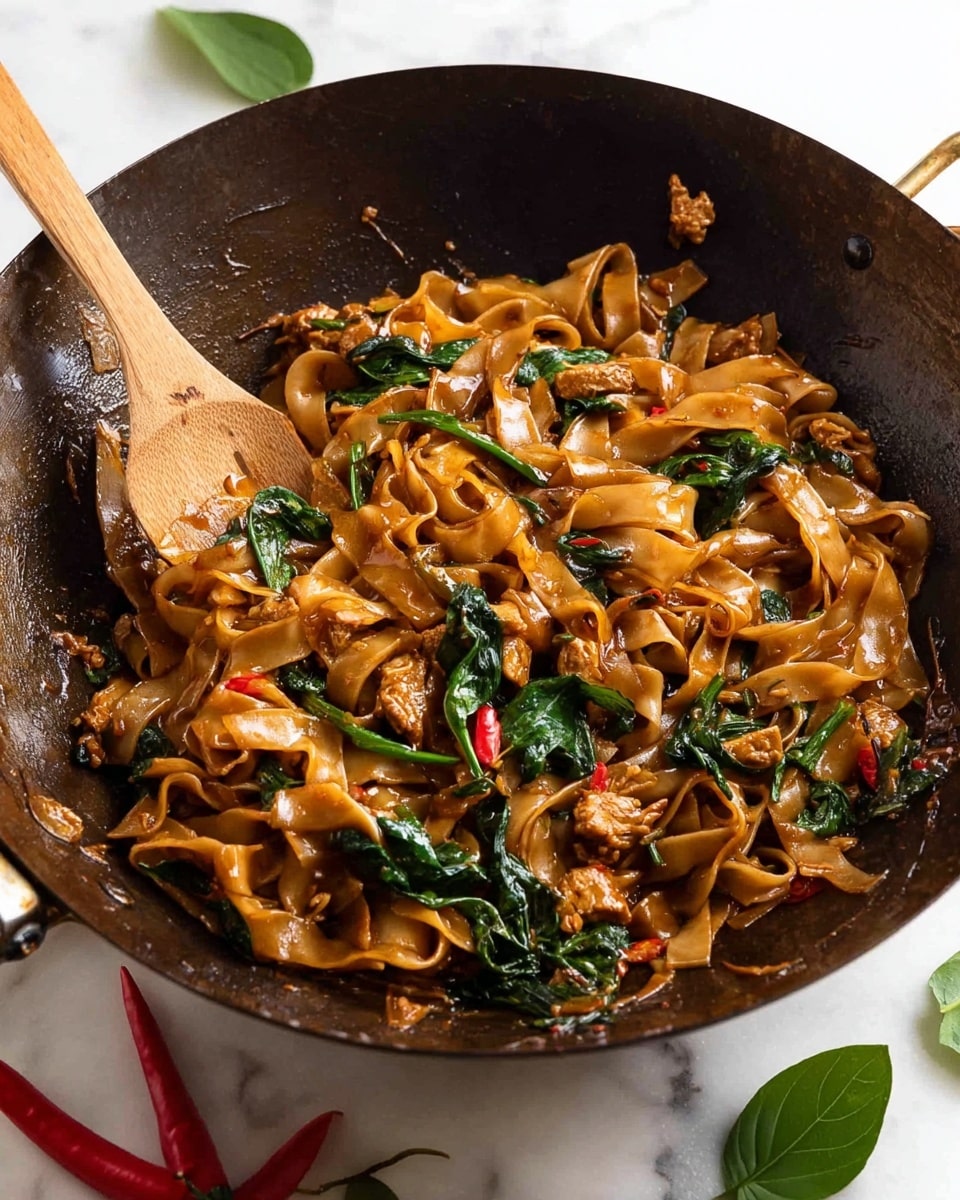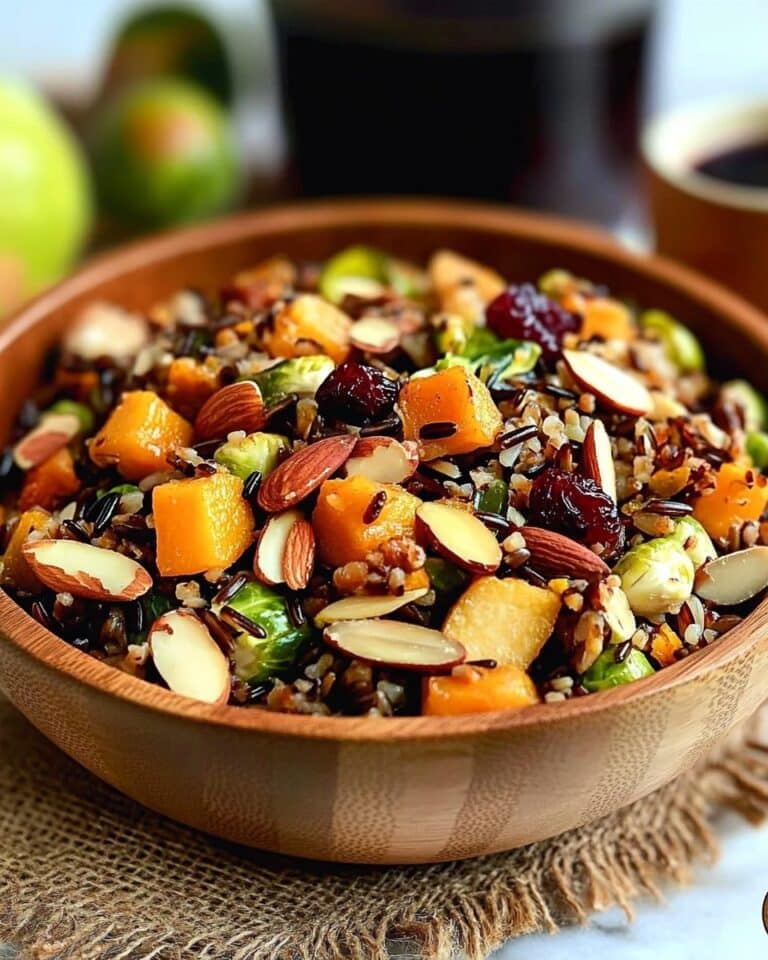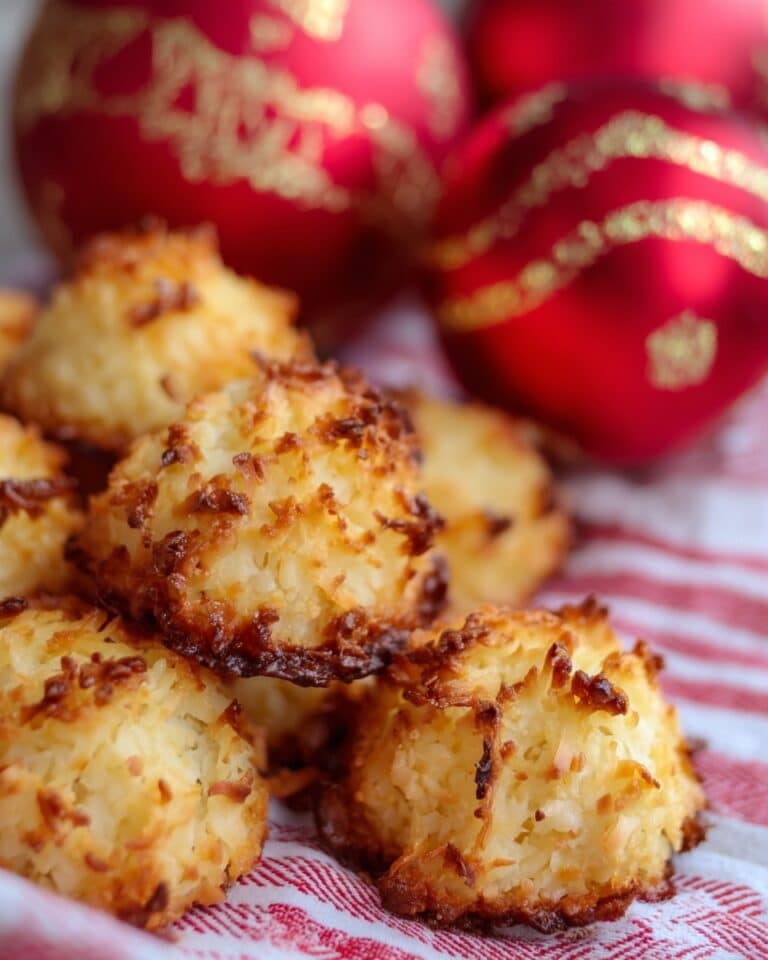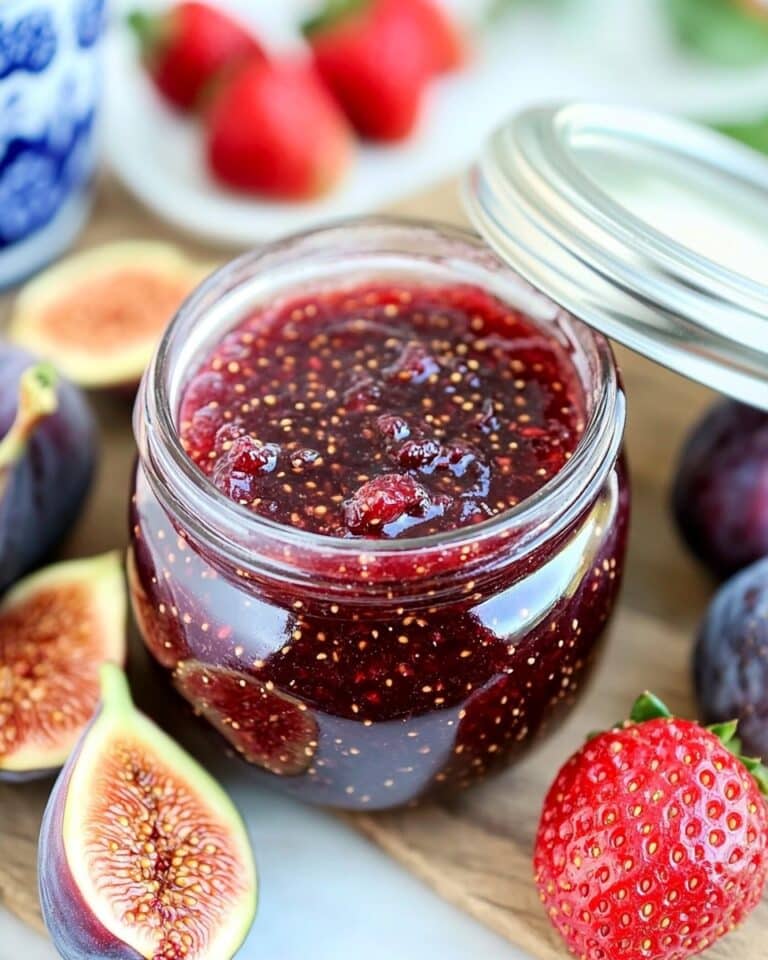If you love bold, spicy, and aromatic stir-fries that can be whipped up in a flash, this Drunken Noodles (Pad Kee Mao) Recipe is a total winner. I first tried this dish at a cozy Thai place near my neighborhood, and I absolutely fell in love with how the garlicky, chili-infused sauce clings to those wide rice noodles. Honestly, once you get the hang of it, you’ll see how versatile and fast this dish is, making it perfect for busy weeknights or when you want something a little more exciting than your usual dinner routine.
What really makes this Drunken Noodles (Pad Kee Mao) Recipe stand out is the balance between the spicy heat, the savory depth from the oyster and soy sauces, and the fresh brightness from basil leaves. Plus, it’s got that satisfying chewy noodle texture that just keeps you going back for more. Whether you’re serving it for a casual meal or bringing it to a dinner party, it’s sure to impress and satisfy.
Why You’ll Love This Recipe
- Quick and Easy: You can have this delicious meal ready in under 20 minutes, perfect for busy days.
- Bold Flavors: The combination of garlic, chili, oyster sauce, and basil delivers that unmistakable Thai punch.
- Customizable Heat: Adjust the chili amount to suit your spice tolerance without losing the dish’s charm.
- Healthy and Satisfying: Lean protein and fresh herbs make this a balanced, nourishing meal you’ll feel good about.
Ingredients You’ll Need
These ingredients come together harmoniously to create the authentic taste of Drunken Noodles (Pad Kee Mao). Picking the right noodles and fresh herbs really makes a difference, so I want to share some shopping tips that’ll help you nail this recipe every time.
- Dried wide rice noodles: I recommend using the ones labelled as “Pad Thai” rice noodles—they hold the sauce beautifully without getting mushy.
- Oil (peanut, vegetable, or canola): Peanut oil adds a lovely nutty aroma but any neutral oil works great.
- Garlic: Fresh minced garlic is key for that punch of aroma and flavor.
- Birds eye chili or Thai chilies: Deseeded and finely chopped for heat without overwhelming the dish.
- Onion: Thinly sliced to add a little sweetness and texture.
- Chicken thighs (or breast): I personally prefer thighs because they stay juicy and tender during quick stir-frying.
- Fish sauce (or soy sauce): Adds that savory umami depth—fish sauce gives authenticity, but soy sauce works if you’re avoiding fish.
- Green onions: Cut into chunks for freshness and mild crunch.
- Thai or Holy Basil leaves (sub regular basil): The fresh herbaceous note is the finishing touch—Thai basil gives a subtle aniseed hint but regular basil is a fine substitute.
- Oyster sauce: This enriches the noodles with a sweet, savory complexity.
- Light and dark soy sauce: Both add color and flavor layers; if you can’t find both, mixing regular soy sauce with a bit of dark soy does the trick.
- Sugar: Just a pinch to balance the savory and spicy elements.
- Water: To loosen the sauce slightly for better coating of the noodles.
Variations
I love how flexible this Drunken Noodles (Pad Kee Mao) Recipe is—once you’ve nailed the basic flavor profile, you can really make it your own. Whether it’s swapping proteins, adjusting spice levels, or trying different herbs, there’s plenty of room to customize.
- Vegetarian version: I often swap out chicken for tofu or mushrooms, adding extra veggies like bell peppers and snap peas for a colorful, filling dish.
- Seafood delight: Shrimp or squid work wonderfully if you want a lighter seafood twist—I learned that adding seafood needs just a slightly shorter cooking time to keep it tender.
- Spice level tweaks: I dial down the chili if I’m cooking for picky eaters, or add more for spice lovers; this dish holds up well to personal heat preferences.
- Herb substitutions: If you can’t find Thai basil, regular sweet basil, or even mint, offers a nice fresh zip to the noodles while keeping that fresh herbal vibe.
How to Make Drunken Noodles (Pad Kee Mao) Recipe
Step 1: Prepare your noodles
The noodles really set the stage here, so follow the package instructions carefully to get them just right—soft but still springy and not mushy. When I first tried overcooking my rice noodles, I ended up with a soggy mess that didn’t hold the sauce well. A good tip: rinse in cold water after cooking to stop the cooking process and drain thoroughly before adding them to the stir fry.
Step 2: Whip up the sauce
While your noodles are soaking or cooking, mix together oyster sauce, light and dark soy sauces, sugar, and water in a small bowl. I find this helps keep everything balanced and ready to go once your stir fry is sizzling. Having this ready means you won’t overcook anything waiting for the sauce.
Step 3: Sizzle aromatics and protein
Heat oil in a wok or a large heavy pan over high heat—that intense heat is key for that slightly smoky sear. Toss in minced garlic and finely chopped chilies, and stir-fry for about 10 seconds. (Beware of the intense chili fumes here—I always turn my face slightly away to avoid coughing!) Then, add sliced onion and cook for 1 minute until softened. Next, stir in the bite-size chicken pieces and splash in fish sauce for that punchy savory depth. Stir-fry for around 2 minutes until the chicken is just cooked through but still tender.
Step 4: Combine noodles, sauce, and finish
Add green onions, noodles, and your pre-mixed sauce to the pan. Cook everything together for about 1 minute, tossing constantly so the sauce thickens and clings to every noodle strand. Right at the end, turn off the heat and immediately add the fresh Thai basil leaves. Toss gently until they just wilt—that’s the secret to keeping their fresh aroma alive and vibrant in the dish. Serve immediately to enjoy the best texture and flavor.
Pro Tips for Making Drunken Noodles (Pad Kee Mao) Recipe
- High Heat Stir Frying: A smoking-hot pan is essential for that slightly charred, smoky flavor—don’t overcrowd your pan or the noodles will steam instead of fry.
- Chili Handling: I always deseed my birds eye chilies to tame the heat while keeping the flavor; wearing gloves helps too!
- Fresh Basil Timing: Add your basil off the heat to preserve that fresh, bright flavor—it wilts quickly and losing it early loses the charm.
- No Overcooking Noodles: Under-cooking noodles slightly is better than overdoing it, as they will soften more during stir-fry; rinsing with cold water stops excess cooking.
How to Serve Drunken Noodles (Pad Kee Mao) Recipe
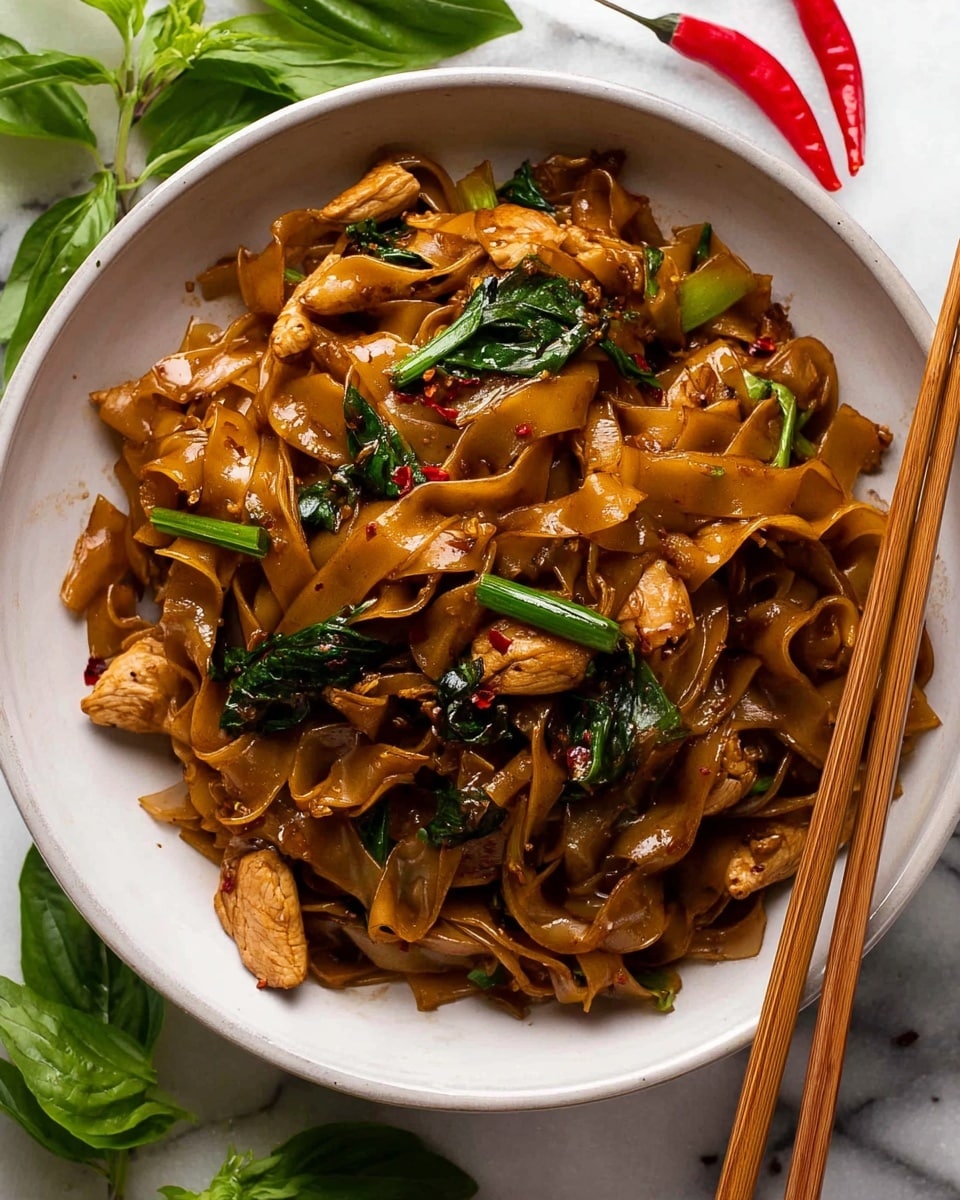
Garnishes
I usually sprinkle extra sliced fresh chili or a wedge of lime on the side for anyone wanting an extra kick or a zesty tang. Sometimes, I’ll add a few crushed peanuts for a nice textural contrast—though not traditional, it’s a fun twist my family loves. Fresh cilantro can also be a lovely garnish if you like herbaceous brightness.
Side Dishes
If you want to keep it simple and balanced, steamed jasmine rice or a clear broth soup work well alongside this hearty stir-fry. For extra veggies, I often serve it with a light cucumber salad dressed in rice vinegar and a sprinkle of chili flakes—the freshness really cuts through the richness.
Creative Ways to Present
For special occasions, I like to plate the noodles in a neat nest with extra basil leaves on top and a side of pickled vegetables for color contrast. It’s also fun to serve in individual banana leaf bowls for a festive, authentic feel—plus, it makes cleanup a breeze!
Make Ahead and Storage
Storing Leftovers
I keep leftovers in an airtight container in the fridge for up to 2 days. Noodles tend to soak up sauce and thicken, so before reheating, I add a splash of water or broth and stir so it loosens back up nicely.
Freezing
Freezing isn’t my top recommendation for Drunken Noodles as the texture can change, but if you need to, freeze in a sealed container for up to 1 month. Thaw overnight in the fridge and reheat gently to avoid drying out the chicken and noodles.
Reheating
I prefer reheating in a hot skillet over medium heat, stirring in some additional water or sauce to keep things moist. Microwaving works too, but be sure to cover and add moisture because the noodles tend to dry out easily.
FAQs
-
Can I make Drunken Noodles (Pad Kee Mao) Recipe vegetarian?
Absolutely! Swap the chicken for firm tofu, mushrooms, or mixed vegetables. Use soy sauce instead of fish sauce for a fully vegetarian version. Adding extra veggies like bell peppers and zucchini adds great texture and nutrition.
-
What type of noodles should I use?
Wide dried rice noodles are best as they hold the sauce well and give authentic texture. If you can’t find wide ones, thinner rice noodles can work, but watch cooking times carefully to avoid mushiness.
-
How spicy is Drunken Noodles (Pad Kee Mao)?
The traditional spice level comes from using two birds eye chilies, which gives a nice heat without overpowering. You can adjust the chili quantity or deseed them to suit your taste preferences easily.
-
Can I prepare this recipe ahead of time?
You can prep ingredients like chopping veggies and mixing the sauce ahead to save time. However, I recommend stir-frying and serving fresh for best flavor and texture as the basil and noodles are best enjoyed immediately.
Final Thoughts
I truly love how this Drunken Noodles (Pad Kee Mao) Recipe brings bold Thai flavors right to your home kitchen without fuss or fancy ingredients. It’s become one of my go-to dishes when I want something quick, satisfying, and packed with flavor—perfect for sharing with family or impressing friends. I’m confident once you try it, you’ll find it a staple in your meal rotation too. So, get cooking, enjoy the aromas, and savor every spicy, aromatic bite!
Print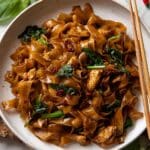
Drunken Noodles (Pad Kee Mao) Recipe
- Prep Time: 10 minutes
- Cook Time: 6 minutes
- Total Time: 16 minutes
- Yield: 2 to 3 servings
- Category: Main Course
- Method: Stir-frying
- Cuisine: Thai
Description
Drunken Noodles (Pad Kee Mao) is a classic Thai stir-fried noodle dish known for its bold, spicy flavors and fragrant basil. Featuring wide rice noodles stir-fried with garlic, bird’s eye chili, chicken, and a savory sauce made from oyster and soy sauces, this dish delivers a perfect balance of heat, sweetness, and umami. Quick to prepare and packed with fresh ingredients, it’s a delicious and satisfying meal that captures the essence of Thai street food at home.
Ingredients
Noodles
- 7 oz / 200g dried wide rice noodles (Pad Thai style)
Stir Fry
- 2 tbsp oil (peanut, vegetable, or canola)
- 3 large cloves garlic, minced
- 2 bird’s eye chilies or Thai chilies, deseeded and finely chopped
- 1/2 onion, sliced
- 200 g / 7 oz chicken thighs, cut into bite-size pieces (breast optional)
- 2 tsp fish sauce (or soy sauce as substitute)
- 2 green onions, cut into 3cm / 2-inch pieces
- 1 cup Thai Holy Basil leaves (or regular Thai basil)
Sauce
- 3 tbsp oyster sauce
- 1 1/2 tbsp light soy sauce
- 1 1/2 tbsp dark soy sauce
- 2 tsp sugar
- 1 tbsp water
Instructions
- Prepare noodles: Cook the dried rice noodles according to the package instructions until just tender. Drain and set aside.
- Mix sauce: In a small bowl, combine oyster sauce, light soy sauce, dark soy sauce, sugar, and water. Stir well until sugar dissolves.
- Heat oil and aromatics: Heat oil in a wok or large heavy-based skillet over high heat. Add minced garlic and chopped chilies, stir-frying for about 10 seconds until fragrant. Be careful not to inhale the fumes as the chili can cause coughing.
- Sauté onion: Add sliced onion and cook for 1 minute until slightly softened.
- Cook chicken: Add chicken pieces and fish sauce to the wok. Stir-fry for around 2 minutes until the chicken is fully cooked through.
- Add green onions, noodles, and sauce: Toss in the green onions, cooked noodles, and the prepared sauce. Stir-fry for 1 minute, allowing the sauce to reduce slightly and coat the noodles evenly.
- Finish with basil: Remove from heat, immediately add the basil leaves, and toss gently just until wilted. Serve the dish immediately while hot.
Notes
- Use wide rice noodles labeled as Pad Thai style for authentic texture; thinner noodles can be substituted but may alter the dish’s character.
- Adjust the number of bird’s eye chilies to your preferred spice level. Alternatively, use a spoonful of chili paste added with the chicken.
- Thai Holy Basil has a subtle aniseed flavor and is preferred; regular Thai basil is a good substitute and more readily available.
- You can substitute the light and dark soy sauces with regular all-purpose soy sauce, but avoid using all dark soy sauce, which can overpower the dish.
- Nutrition information is based on a serving size assuming about 3 servings from this recipe.
Nutrition
- Serving Size: 1 serving (approximately 200g)
- Calories: 350 kcal
- Sugar: 5 g
- Sodium: 900 mg
- Fat: 12 g
- Saturated Fat: 2.5 g
- Unsaturated Fat: 8 g
- Trans Fat: 0 g
- Carbohydrates: 45 g
- Fiber: 2 g
- Protein: 22 g
- Cholesterol: 50 mg


